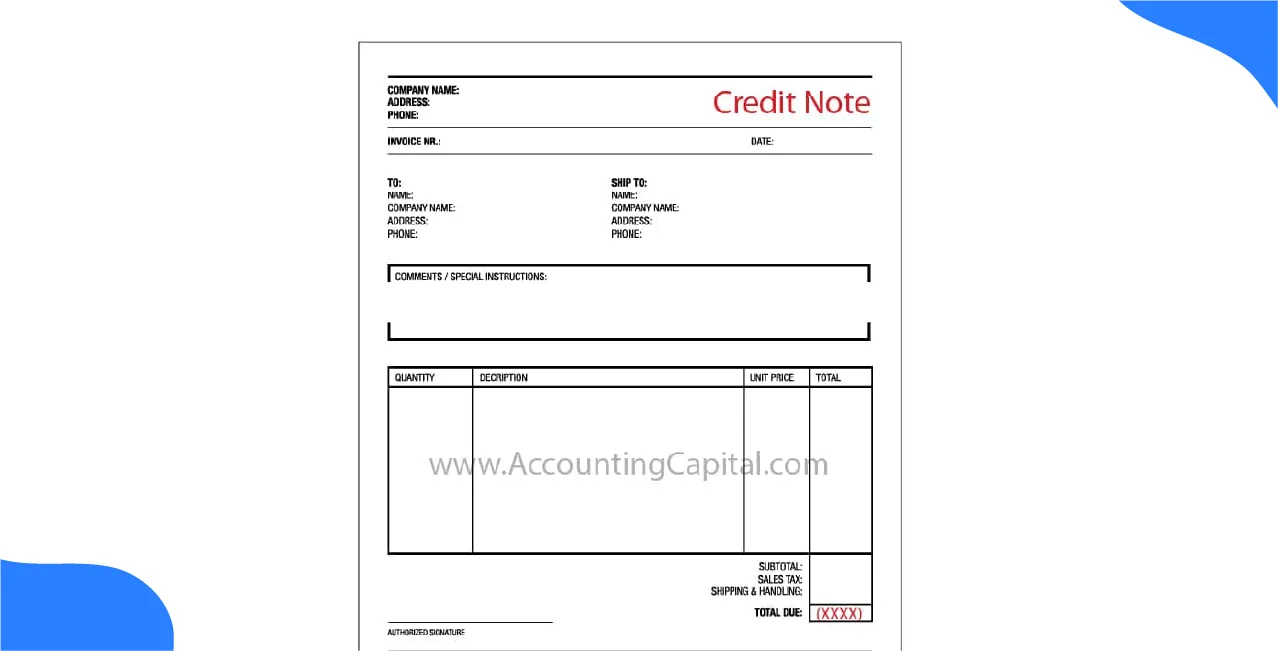
Author
LoansJagat Team
Read Time
6 Min
04 Aug 2025
What Is A Credit Note? Format, Example & Use In Accounting
A credit note is a financial document issued to reduce an earlier invoice due to returns, discounts, or errors made.
Let’s understand this about credit note with an example:
Mr. Ramesh had purchased raw materials worth ₹1,20,000 from a supplier. Upon delivery, he found that goods worth ₹20,000 were damaged and returned them immediately. A credit note of ₹20,000 was issued by the supplier under GST provisions. Mr. Ramesh's liability to pay was reduced accordingly. The tax on ₹20,000 (say, 18%) was adjusted in the next return cycle.
As Ramesh looked at the note, he laughed and said, “Yeh hui na baat! Ab hisaab barabar.”
This ensured both the seller and buyer had accurate records and tax compliance. Credit notes are an essential part of a transparent accounting system, especially under GST.
This blog explains what a credit note is, why and when it is issued, its legal format, accounting treatment, tax adjustments, and real-world business uses, supported with tables, numerical examples, and official government guidelines.
Definition of Credit Notes
A credit note is issued when a mistake is found in an invoice. It is mostly used when goods are returned or a customer is overcharged. Credit notes help in keeping accounting clean and accurate. They also help with GST adjustments.
Example: Ms. Meera had bought electronic goods for ₹50,000. Later, she returned faulty items worth ₹8,000. A credit note for ₹8,000 was issued by the seller to fix the invoice.
Purpose and Importance of Credit Notes
Credit notes are issued for many reasons. They help in correcting accounts and making tax adjustments easier.
- Fix invoice mistakes: Sometimes, the wrong amount or wrong items are added to the bill. A credit note is issued to correct that mistake without changing the original invoice.
- Reduce extra tax charged: If too much GST or tax is charged by mistake, it can be reduced by using a credit note. This helps both the buyer and seller pay only the right amount of tax.
- Keep accounts correct: Credit notes help in showing the right amount in the books. They make sure all sales and returns are properly recorded.
- Let customers use the amount for future buys: When customers return items, they may not want cash back. A credit note is given so they can use that amount later for another purchase.
Example: Company A had sent an invoice that included ₹10,000 extra by mistake. A credit note was issued for that extra amount of ₹10,000, and the extra tax was also adjusted in their GST return.
Read More – What is a Journal Entry? Meaning, Format & Accounting Examples
Common Reasons for Issuing Credit Notes
Credit notes are not only used when goods are returned. They are also issued in many other situations to fix errors and maintain proper records. Businesses use credit notes to stay fair, accurate, and tax-compliant. Below are some common reasons:
These credit notes help both buyers and sellers adjust their accounts correctly and reduce the tax amount wherever needed.
Legal Format as per GST Law in India
As per the GST Council of India, every credit note must follow a proper format. If this format is not followed, it may cause problems during audits or GST return filing.
A credit note must include:
Example: Arvind had purchased furniture worth ₹1,00,000 from a vendor on 15th June 2025 (Invoice No: INV‑205). Later, a part of the furniture worth ₹15,000 was found to be damaged during delivery. As a result, a credit note was issued to Mr. Arvind on 1st July 2025.
The credit note was prepared in the following manner:
- Credit Note No: CN‑015
- Date of Issue: 01‑07‑2025
- Referenced Invoice: INV‑205, dated 15‑06‑2025
- Returned Amount: ₹15,000
- Tax (GST @18%): ₹2,700
- Total Value of Credit Note: ₹17,700
Mr. Arvind smiled after receiving the note and said, “Ab sab kuch paper pe sahi hai, tension khatam!”
Mandatory Fields Required in a Credit Note as per GST Law
When a credit note is issued under GST, it must follow a specific format. These details help in proper record-keeping and allow GST returns to be filed without mistakes. If any field is missing, the credit note may not be accepted during assessment or audits.
Let’s take the case of Ms. Kavita, a wholesaler who returned some goods to her supplier. A credit note was issued to her, and it followed all the GST-required fields listed below.
Note: All these fields are mandatory.
Accounting Treatment of Credit Notes
In accounting, every credit note affects the books through a journal entry. The value shown in the credit note is recorded properly to reflect a reduction in income and receivables.
Let’s look at Mr. Deepak’s case. He returned some products worth ₹12,000 (including GST). To adjust the books, the following journal entry was passed.
- A credit note for ₹12,000 (₹10,000 goods + ₹2,000 GST) was issued.
- The seller's accounting team made this journal entry:
- Debit: Sales Return ₹10,000
- Debit: GST Adjustment ₹2,000
- Credit: Customer’s Account ₹12,000
Here, the GST is debited because the seller originally collected GST on the sale and now needs to reverse that tax liability due to the return. By debiting the GST Adjustment account, the seller reduces their GST payable to the government.
Also Read - What Is Debit And Credit? Accounting Basics With Real-Life Examples
Aligning the tax records with the actual sale value after the return.This ensures both the revenue and GST liability are accurately reduced, and the customer's account is adjusted accordingly.
Tax Adjustments under GST
When a credit note is issued, the supplier must reduce the GST collected from the buyer. This reduction lowers the overall tax that needs to be paid to the government. It is important that this tax change is shown in GSTR‑1 and GSTR‑3B for that month.
As per the GST Flyer Credit Notes, the credit note must be correctly linked to the invoice to allow the tax to be reduced properly.
Let us take the example of Mrs. Swati, who returned goods worth ₹20,000 from her original purchase of ₹1,00,000. The tax originally charged was 18%, which was ₹18,000. After issuing a credit note, tax of ₹3,600 was reduced.
This tax adjustment helped Mrs. Swati pay only the correct amount of GST, avoiding any overpayment.
Use in Business Scenarios
Credit notes are used in many business situations to fix common issues. They are useful across sectors and help maintain proper billing and tax records.
Conclusion
Credit notes are not just documents; they are essential tools for transparency in accounting and GST compliance. They help businesses correct their mistakes, return amounts legally, and reduce tax liabilities as per the government rules.
Issued with proper format and reason, they help avoid disputes, audits, and financial discrepancies. “Jo dikhta hai, wahi bikta hai”, and with credit notes, what is recorded correctly, always survives scrutiny.
FAQs
Is a credit note mandatory under GST?
Yes, it must be issued when correcting any GST invoice.
Can a credit note be issued after filing GSTR-1?
Yes, but it must be reflected in subsequent returns.
Can tax be adjusted through a credit note?
Yes, output GST liability is reduced accordingly.
Is there a format for credit notes?
Yes, it must follow GST Council-prescribed structure.
How long should credit notes be stored?
As per law, for 6 years from the filing date.
Other Related Pages | |||
About the Author

LoansJagat Team
‘Simplify Finance for Everyone.’ This is the common goal of our team, as we try to explain any topic with relatable examples. From personal to business finance, managing EMIs to becoming debt-free, we do extensive research on each and every parameter, so you don’t have to. Scroll up and have a look at what 15+ years of experience in the BFSI sector looks like.

Quick Apply Loan
Subscribe Now
Related Blog Post


